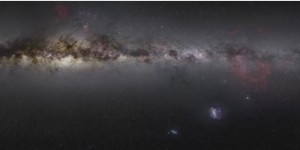
A new study has confirmed that two potentially habitable planets in nearby system are actually rocky worlds.
In May this year, scientists from Massachusetts Institute of Technology, the University of Liège, and other schools announced the discovery of a planetary system hosting three potentially habitable planets. These scientists used NASA’s Hubble Space Telescope to catch the rare event of a double transit, with two planets passing nearly in tandem in front of their star – TRAPPIST-1, located 40 light years from Earth. TRAPPIST-1 is an extremely cool dwarf star, and emits mostly infrared radiations, thus making it appear red in color. TRAPPIST-1 planetary system was discovered using TRAPPIST telescope (TRAnsiting Planets and PlanetesImals Small Telescope) established in Chile.
Now the same group of scientists has revealed that the two innermost planets in the system are rocky worlds. The team also suggests that the atmospheres of both planets probably not large and diffuse, but are compact like that of Earth, Venus, and Mars.
“We thought, maybe we could see if people at Hubble would give us time to do this observation, so we wrote the proposal in less than 24 hours, sent it out, and it was reviewed immediately,” said Dr. Julien de Wit, the first author of the study and a postdoc in MIT’s Department of Earth, Atmospheric and Planetary Sciences.
“Now for the first time we have spectroscopic observations of a double transit, which allows us to get insight on the atmosphere of both planets at the same time.”
“The data turned out to be pristine, absolutely perfect, and the observations were the best that we could have expected,” de Wit says. “The force was certainly with us.”
The data obtained from Hubble suggested that both transiting planets have more compact atmospheres, similar to those of rocky planets such as Earth, Venus, and Mars.
“Now we can say that these planets are rocky. Now the question is, what kind of atmosphere do they have?” de Wit says.
“The plausible scenarios include something like Venus, where the atmosphere is dominated by carbon dioxide, or an Earth-like atmosphere with heavy clouds, or even something like Mars with a depleted atmosphere. The next step is to try to disentangle all these possible scenarios that exist for these terrestrial planets.”
The scientists now want more telescopes established on the ground to investigate this planetary system further. They have also formed a consortium, dubbed SPECULOOS (Search for habitable Planets Eclipsing ULtra-cOOl Stars), and working to build four larger telescope in Chile that will be dedicated to monitor brightest ultracool dwarf stars in the skies over the southern hemisphere.
“With more observations using Hubble, and further down the road with James Webb, we can know not only what kind of atmosphere planets like TRAPPIST-1 have, but also what is within these atmospheres,” de Wit says. “And that’s very exciting.”
The detailed findings of the study have been published in Nature.

